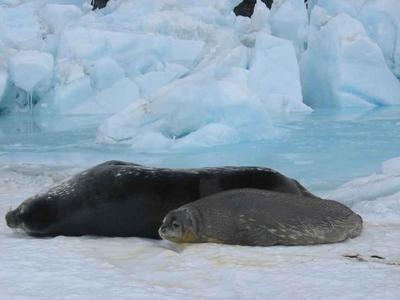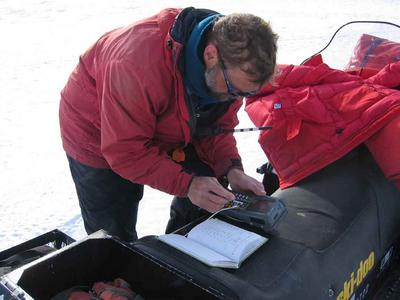24 November, 2003
Seal census number 5 was interrupted mid-day by an almost total solar
eclipse. The moon was scheduled to cast its shadow as it passed
between the sun and Earth starting at 11:08 this morning. The
eclipse peak would be at 12:08. The last eclipse over Antarctica
occurred in 1985, and the next will be in 2021. Since I couldn't
guarantee that I would have the opportunity to see the eclipse 18
years from now, I set my watch for 11:00 so I wouldn't miss a moment
of this event.
The weather forecast was predicting the arrival of a weather system
from the Ross Sea sometime during the day. As you can guess, it
showed up right on time, with hazy clouds crossing the sun around
10:45. I'd like to say that it was spectacular, but in all honesty
it was just a few shades less than that. It was your basic subtle
eclipse experience. It did get noticeably shadier during the
hour-long eclipse. It was too dark to see well with my sunglasses
on, and it seemed to be a bit darker than one would normally expect
from a hazy cloud cover. It's easy to imagine that you are seeing an
eclipse-induced shadow across the sun when you're privileged enough
to be in Antarctica for an event that only occurs once every 18
years.
What were the seals doing today? 934 were out on the ice waiting to
be counted. While most were tagged, there are still some untagged
adults out there. When you consider that the database accumulated
over the past 34 years has over 16,000 seals, the potential for
seeing tagged seals is enormous. As of this point, we have seen a
total of 1547 tagged individuals during our 5 censuses. We have 3
more censuses to complete over the next 2 weeks. It will be
interesting to see how the total number of tagged animals seen
changes by the end of those censuses.
Daily Haiku:
Antarctic eclipse
Moon shadow across the earth
Too bad there were clouds

Even if it's almost impossible to see the shadow of the moon over the sun in these photos, I had to take a few pictures!

As the sun is higher in the sky and temperatures rise, melt pools such as this one are appearing on the surface of the ice.

A slush-covered pup emerges from a hole after swimming.

Mark Johnston records tag information in his field notebook and enters it into the computer.
Contact the TEA in the field at
.
If you cannot connect through your browser, copy the
TEA's e-mail address in the "To:" line of
your favorite e-mail package.
|
